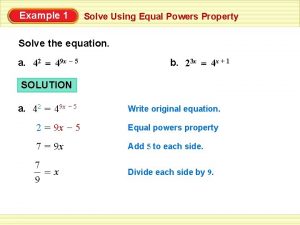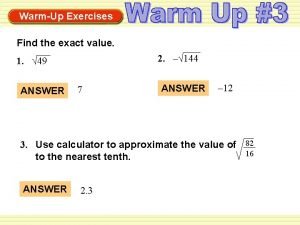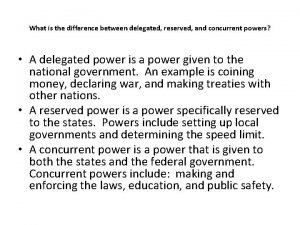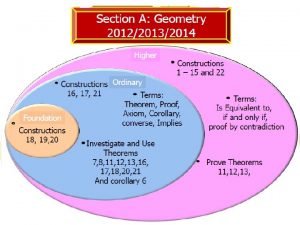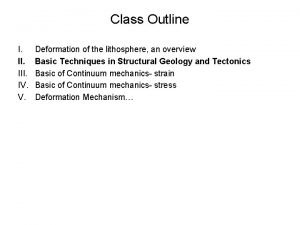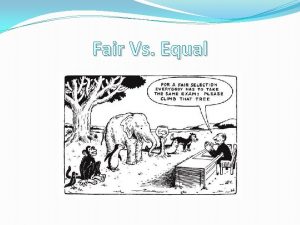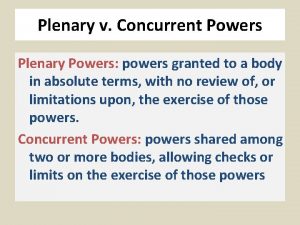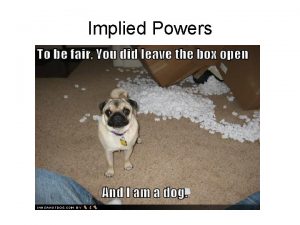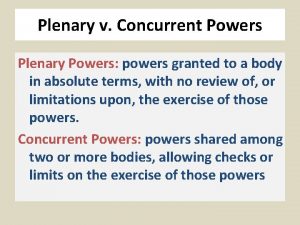Example 1 Solve Using Equal Powers Property Solve



















- Slides: 19

Example 1 Solve Using Equal Powers Property Solve the equation. a. 42 = 49 x – 5 b. 23 x = 4 x + 1 SOLUTION a. 42 = 49 x – 5 Write original equation. 2 = 9 x – 5 Equal powers property 7 = 9 x Add 5 to each side. 7 =x 9 Divide each side by 9.

Example 1 Solve Using Equal Powers Property ANSWER 7 The solution is. Check this in the original equation. 9 b. 23 x = 4 x + 1 Write original equation. 23 x = ( 22)x + 1 Rewrite 4 as 22 so powers have same base. 23 x = 22( x + 1) Power of a power property 3 x = 2( x + 1) Equal powers property 3 x = 2 x + 2 Distributive property x=2 Subtract 2 x from each side.

Example 1 Solve Using Equal Powers Property ANSWER The solution is 2. Check this in the original equation.

Solve Using Equal Powers Property Checkpoint Solve the equation. 1. 27 x – 4 = 23 ANSWER 1 2. 3 x – 2 = 35 x – 6 ANSWER 1 3. 5 x + 3 = 54 x – 9 ANSWER 4 4. 2 x + 2 = 16 x – 4 ANSWER 6

Checkpoint Solve Using Equal Powers Property Solve the equation. 5. 64 x + 1 = 368 x – 1 6. 10 x – 3 = 1002 x – 9 ANSWER 1 4 ANSWER 5

Example 2 Take a Common Logarithm of Each Side Solve 3 x = 5. SOLUTION 3 x = 5 log 3 x = log 5 x log 3 = log 5 x = log 5 log 3 x ≈ 1. 465 Write original equation. Take common logarithm of each side. Power property of logarithms Divide each side by log 3. Use a calculator.

Example 2 Take a Common Logarithm of Each Side ANSWER The solution is about 1. 465. Check this in the original equation.

Example 3 Take a Common Logarithm of Each Side Solve 103 x – 1 = 19. SOLUTION 103 x – 1 = 19 Write original equation. log 103 x – 1 = log 19 Take common logarithm of each side. 3 x – 1 = log 19 log 10 x = x 3 x = 1 + log 19 Add 1 to each side. 1 + log 19 Divide each side by 3. x = 3 x ≈ 0. 760 Use a calculator.

Example 3 Take a Common Logarithm of Each Side CHECK You can check the solution by substituting it into the original equation. Or, you can check the solution graphically by graphing each side of the original equation as a function. y 1 = 103 x – 1 and y 2 = 19 The two graphs intersect when x ≈ 0. 760.

Checkpoint Take a Common Logarithm of Each Side Solve the equation. 7. 2 x = 9 ANSWER 3. 170 8. 4 x = 5 ANSWER 1. 161 9. 3 x = 40 ANSWER 3. 358 10. 103 x = 5 ANSWER 0. 233 11. 102 x + 5 = 6 ANSWER – 2. 111

Checkpoint Take a Common Logarithm of Each Side Solve the equation. 12. 10 – x – 4 = 13 ANSWER – 1. 230

Example 4 Solve a Logarithmic Equation Solve log 7 ( 4 x – 3 ) = log 7 ( x + 6 ). SOLUTION log 7 ( 4 x – 3 ) = log 7 ( x + 6 ) 4 x – 3 = x + 6 Write original equation. Equal logarithms property 4 x = x + 9 Add 3 to each side. 3 x = 9 Subtract x from each side. x =3 Divide each side by 3. ANSWER The solution is 3. Check this in the original equation.

Example 5 Exponentiate Each Side Solve log 2 ( 3 x + 1 ) = 4. SOLUTION log 2 ( 3 x + 1 ) = 4 2 log 2 ( 3 x + 1 ) = 24 3 x + 1 = 16 3 x = 15 x = 5 Write original equation. Exponentiate each side using base 2. b logb x = x Subtract 1 from each side. Divide each side by 3. ANSWER The solution is 5. Check this in the original equation.

Checkpoint Solve a Logarithmic Equation Solve the equation. 13. log 3 ( x + 2 ) = log 3 ( 2 x – 5 ) ANSWER 7 14. log 5 ( 8 x – 9 ) = log 5 ( 3 x + 1 ) ANSWER 2 15. log 4 ( 7 x + 2 ) = 2 ANSWER 2 16. log 3 ( 5 x + 1 ) = 4 ANSWER 16

Example 6 Check for Extraneous Solutions Solve log 10 x + log ( x – 3 ) = 2. Check for extraneous solutions. SOLUTION log 10 x + log ( x – 3) = 2 log [ 10 x ( x – 3 ) ] = 2 10 log [10 x ( x – 3 )] = 102 Write original equation. Product property of logarithms Exponentiate each side using base 10. 10 x ( x – 3 ) = 100 10 log x = x 10 x 2 – 30 x = 100 Simplify.

Example 6 Check for Extraneous Solutions 10 x 2 – 30 x – 100 = 0 Subtract 100 from each side. 10( x – 5 ) ( x + 2 ) = 0 Factor. x =5 or x = – 2 Zero product property The solutions appear to be 5 and – 2. However, when you check these in the original equation or use a graphic check as shown at the right, you can see that x = 5 is the only solution. ANSWER The solution is 5.

Example 7 Use Logarithms with an Exponential Model Radioactive Decay The exponential decay model for predicting the amount A of material left in a radioactive sample after t years is A = A 0 • 2 – t/h where A 0 is the initial amount of the substance and h is the half-life of the substance. Cesium is an element found in rocks and soil. A radioactive form of cesium, 137 Cs (read as “Cesium 137”), has a half-life of about 30. 2 years. How long does it take for 32 grams of 137 Cs to decay to 4 grams?

Example 7 Use Logarithms with an Exponential Model SOLUTION A = A 0 • 2 – t/h Write radioactive decay model. 4 = 32 • 2 – t/30. 2 Substitute 4 for A, 32 for A 0, and 30. 2 for h. 1 = 2 – t/30. 2 8 Divide each side by 32. 1 log 2 3 = log 2 2 – t/30. 2 Take logarithm of each side using base 2. 2 –t – 3 = 30. 2 90. 6 = t logb bx = x Multiply each side by – 30. 2.

Example 7 Use Logarithms with an Exponential Model ANSWER It takes about 90. 6 years for 32 grams of 137 Cs to decay to 4 grams.
 Equal powers property
Equal powers property Solve using the square root property x^2=144
Solve using the square root property x^2=144 48 square root
48 square root Was the united states on the axis powers or allied powers?
Was the united states on the axis powers or allied powers? The central powers ww1
The central powers ww1 What is the difference between expressed and implied powers
What is the difference between expressed and implied powers Implied vs enumerated powers
Implied vs enumerated powers Non legislative powers of congress
Non legislative powers of congress Delegated reserved and concurrent powers
Delegated reserved and concurrent powers Informal checks on the president
Informal checks on the president Equal height equal light
Equal height equal light Equal height equal light
Equal height equal light Is equal sharing and equal grouping
Is equal sharing and equal grouping Opposite angles
Opposite angles Equal area vs equal angle stereonet
Equal area vs equal angle stereonet Product of powers
Product of powers Quotient of powers property
Quotient of powers property Shape 3 sides
Shape 3 sides Associative vs commutative
Associative vs commutative Coparcenary property and separate property
Coparcenary property and separate property
